 |
 |
 |
| |
Dose Escalation, Safety, Tolerability and Pharmacokinetics of a Novel HIV-1 NNRTI, IDX899 in Healthy Subjects
|
| |
| |
Reported by Jules Levin
15th CROI, Feb 3-6, 2008, Boston
D Mayers, M Hard, D Damphousse, B Fielman, J Sullivan-Bolyai, B Belanger and XJ Zhou
Idenix Pharmaceuticals, Inc., Cambridge, MA, USA
AUTHOR CONCLUSIONS & DISCUSSIONS
· Administered orally, IDX899 appears to be safe and well tolerated at single doses up to 1200 mg and multiple doses up to 800 mg QD over seven days in healthy subjects.
· Food enhanced absorption of IDX899; no gender effect was observed.
· No SAEs and no discernable pattern to laboratory abnormalities were observed.
· When combined with atazanavir, IDX899 did not markedly alter atazanavir
pharmacokinetic parameters.
· IDX899 is currently in a proof of concept study in HIV-1 infected patients.
BACKGROUND
· Non-nucleoside reverse transcriptase inhibitors (NNRTIs) are valuable components of antiretroviral combination therapy for the treatment of human immunodeficiency virus type 1 (HIV-1)-infection.
· IDX899 (see Figure 1) is a novel NNRTI drug candidate
for the treatment of HIV-1 infection with potent in vitro antiviral characteristics and
a higher barrier to resistance to efavirenz (EFV).1
· In these Phase I trials, we investigated the safety and pharmacokinetic (PK) profile of IDX899 following single escalating and multiple doses of IDX899 in healthy volunteers.
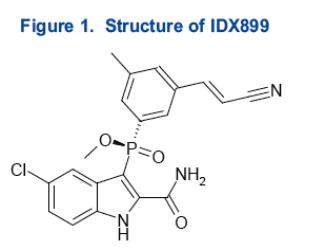
OBJECTIVES
· To evaluate the safety and tolerability of escalating single or multiple doses of IDX899 following oral administration in healthy subjects.
· To evaluate pharmacokinetics of single and multiple doses of IDX899.
· To determine food and gender effect on the pharmacokinetics of IDX899.
Subjects
· The NV-05A-001 trial was a Phase I dose-escalation study that enrolled 76 healthy adult male subjects (56 and 20 for the single dose and repeat dose steps, respectively) and nine female subjects of non-childbearing potential.
Dosing Schedule
· Single-dose escalation - Male subjects (8/dose) were randomized 6:2 ratio to IDX899 or matching placebo to the following single escalating dose cohorts: 50 (fasted), 100 (fasted), 200 (fasted/fed), 400 (fasted/fed), 800 (fed) or 1200 (fed) mg.
· Food effect - During single dose escalation, male subjects randomized to the 200 mg fast cohort received, after a 7-day washout period, an additional dose of 200 mg under fed conditions to assess food effect. An additional cohort of male subjects received a single dose of 400 mg under fed conditions to confirm food effect observed at 200 mg.
· Gender effect - A cohort of non-childbearing healthy females was enrolled and received a single 400 mg dose under fed conditions to assess potential gender difference.
· Multiple doses - After the completion of single dose escalation, two cohorts of male subjects (10/cohort randomized 8:2 active to placebo ratio) were enrolled and received repeat doses of 800 QD or 400 mg BID for 7 days under fed conditions.
PK Sampling and Analysis
· Serial plasma samples were obtained after dosing and quantitated for IDX899 using a validated LC/MS-MS methodology.
· PK parameters, obtained using standard non-compartmental analysis, include Cmax, Tmax, AUCinf/AUC_, C24h/Cmin, and T1/2. Mean ± SD [Median (Range) for Tmax] are presented.
Safety Analysis
· Safety measurements included clinical history, laboratory evaluations, physical examination, vital signs, and adverse event (AE) assessments.
Drug-Drug Interaction Studies
· Drug-drug interaction studies with Truvada (emtricitabine and tenofovir disoproxil fumarate) and Reyataz (atazanavir, ATV) are completed and analyses are in progress. Results from an preliminary analysis are presented for the IDX899/ATV study.
RESULTS
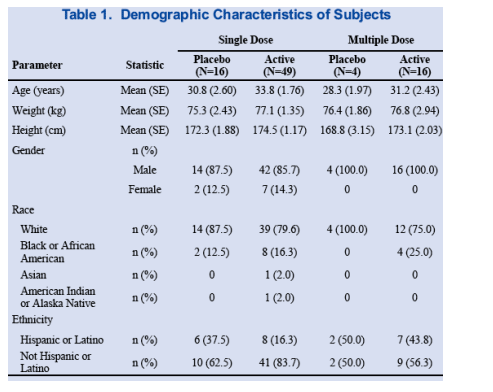
Pharmacokinetics
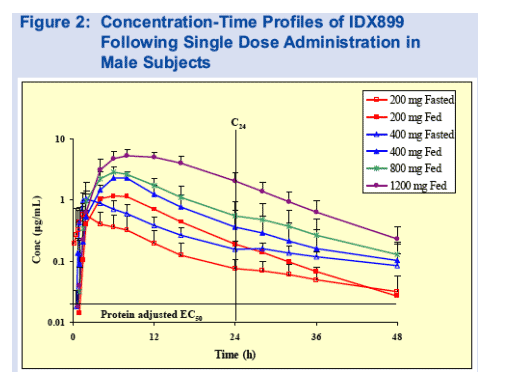
· Dose-proportional PK was observed in the 200 mg to 1200 mg dose range under fed conditions
· Administration of IDX899 with a high-fat/high-calorie meal enhanced exposure by a factor of ~2 fold.
· Concentrations 24 h after single doses of 200-1200 mg exceeded the in vitro protein-binding adjusted EC50 (0.023 _g/mL) of IDX899 by approximately 10 to 40 fold. Steady-state trough concentrations exceed EC50 by approximately 40 to 90 fold.
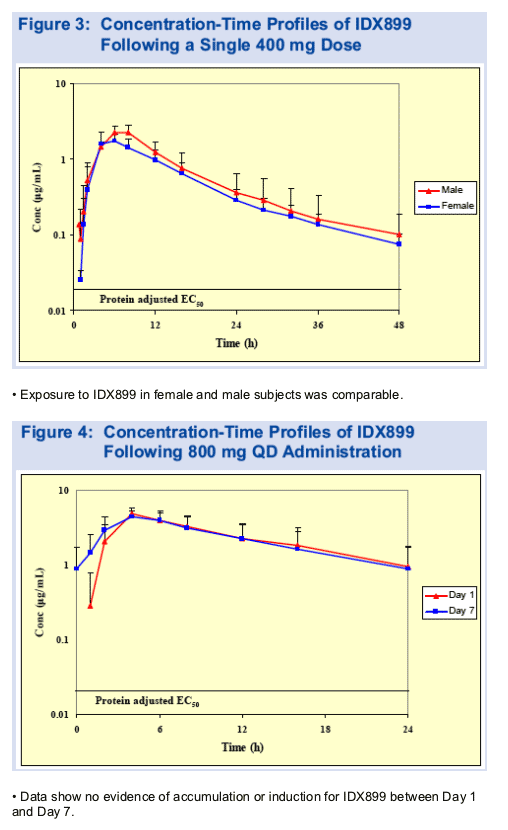
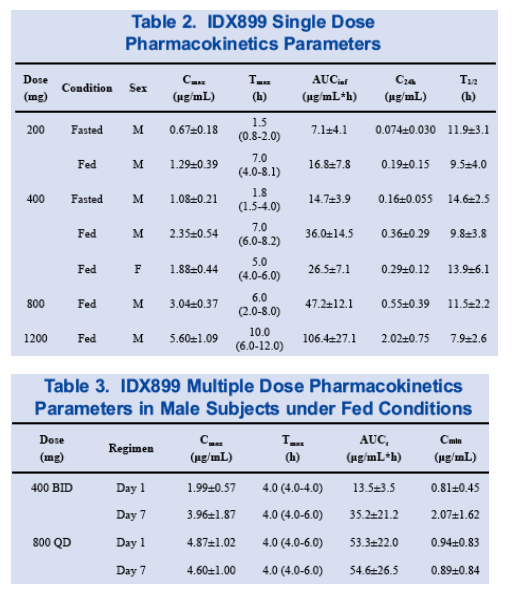
Safety
· There were no serious adverse events reported.
· The most common AEs reported across both single and multiple dose groups were headache (N=5/65), nausea (N=2/65), polyuria (2/65) and abnormal (vivid) dreams (N=2/65). All AEs were mild in intensity with exception of one event of moderate vomiting, in a female subject after a single dose of 400 mg IDX899, which resulted in discontinuation from the study. A second subject, a male in the multiple dose 800 mg group, discontinued for mild pruritus and urticaria which resolved within 26 hours after receiving diphenhydramine.
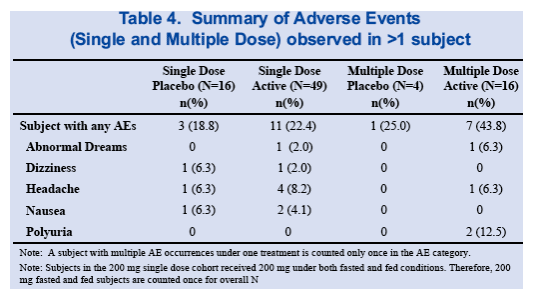
IDX899-Atazanavir Drug-Drug Interaction Study
· This study evaluated the PK interaction potential between ATV and IDX899 in comparison to the RTV-boosted ATV PK in healthy subjects. The single-dose PK of ATV alone, IDX899 alone and the two study drugs in combination was studied in two treatment groups administered respective doses of 100 mg and 800 mg IDX899. RTV-boosted ATV was used as positive control.
· A total of 18 healthy male or female (non-childbearing potential) subjects were enrolled and randomly assigned to one of the above three treatment groups.
· Plasma exposure of ATV was not markedly altered by IDX899.
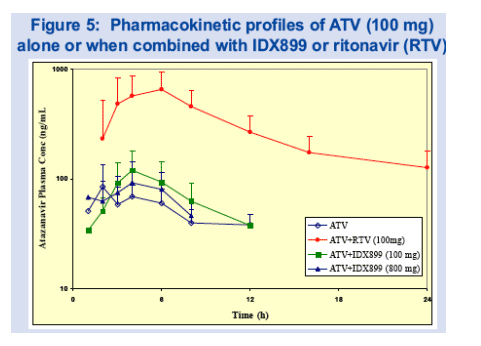
References
1. Richman DD, Jakubik J, Chapron C, et al (2008). 15th Conference on Retroviruses and Opportunistic Infections (CROI), Boston, USA.
|
| |
|
 |
 |
|
|